Administrative
Officials
(Beamten) |
The following article is taken largely
verbatim from "Officials", an article appearing in Kettenhunde: The Newsletter
of Feldgendarmerie-Trupp (Mot.) 200, Volume IV, Number 1 (Jan/Feb 1994). The article
was authored by LTC Louis H. Brown; minor changes in grammar and organization have been
made.
The concept of uniformed civilian personnel in the military
is somewhat difficult to understand. A particularly European idea, the German Army
probably took the idea to its limits in institutionalization.
HISTORY
| In early European armies, soldiers fought while
civilians were hired on to provide certain services. A prime consideration in this
was money; armies in the 17th and 18th centuries represented a significant chunk of a
state's budget. Services and items needed only for war were an unnecessary
expenditure in peacetime, and armies grew to depend on hired civilians for certain items
and services. It was usual, for example, to hire civilian drivers and their oxen
teams to move artillery during campaigns, sparing the expense of maintaining the animals
and drivers at all times. It was not long before an interface between the
soldier-commander and these providers became necessary in order to ensure that the
commander got what he wanted. In both the French and German armies (and no doubt
others as well), the go-between was usually a civilian appointed on a royal patent of
authority to provide the army with supply and services. This individual, who
gradually assumed the duties associated with what we would call a chief of supply and
logistics, was generally afforded a title and a "pecking order" ranking which
placed him in a relative relationship with serving soldiers. Comte de
Rochambeau (comander of the French forces sent to North America during the War for
Independence) had assigned to his suite a Maréchal de camp who was the equivalent
of a brigadier general; his uniform, of a distinct pattern and color, nevertheless bore
the same rank distinctions as a general officer of equivalent rank. |
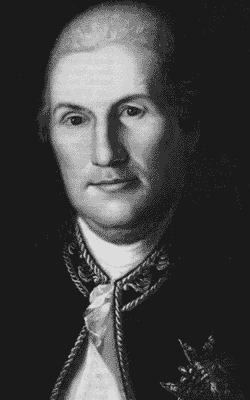
Comte de Rochambeau
|
This system, well-entrenched in the German Armed Forces,
survived to the end of the Great War. Well-developed in terms of uniforms, insignia,
and authority, the officials provided the German Army many of its personnel and logistics
services as well as being responsible for most supply and victualling.
OFFICIALS IN THE WEHRMACHT
Most officials (called Beamten) ranked equivalent to
officers; there were some with equivalent Unteroffiziere mit Portepee (Senior
NCO) ranks. They were members of the Armed Forces according to the Law of Land
Warfare, but were not "soldiers" by the German definition. As officials,
their authority extended only to their specialty field -- unlike soldiers, whose
authority extends to anyone whom the individual outranks. Beamten could not
hold command. They were entitled to all the customs and courtesies associated with
their rank/status, however. In the social order of the day, being an officer was the
peak of the pyramid, if you couldn't be a regular officer, being a reserve officer was
next best, and a very close approximation of that would have been appointment as an
official. In addition to those performing personnel, supply, and logistics
functions, army chaplains, doctors, bandmasters and veterinarians were also officials,
although their uniforms differed significantly from those of the other officials in being
basically those of active officers with distinguishing insignia.
The main difference between officer and official status
depended much on education. Officials were by no means lesser-educated officers --
many had university degrees (which few officers did) -- but they did not meet the
professional education/training requirements for appointment as officers or
soldiers. Most officials tended to remain such although if the military education
qualifications were met, appointment as an officer or soldier could be made. In 1944
the Germans began to laterally appoint all officials to regular officer ranks;
how far this program went is conjectural since it was begun so late. Those taken
over wore regular officer uniforms. Several new "branches", with
corresponding branch colours and insignia, were created to accommodate these individuals.
Many officials, by the way, were Zwoelfender ("Twelvers" -- from
the 12-year service requirement), retirees out of the Reichsheer (1919-1935). One of
the Reichsheer's member benefits had been retraining during the 12th year of service
in a civilian career -- one of the more attractive options was appointment to the Beamtenschule,
a training school for government officials which allowed many to come back into the army as civilian administrators.
It is important to point out that not all
German Army civilians were Beamten; many (including women) were hired on the Civil Service
scale and served in administrative and clerical positions; basically, they were civilian
employees. Women could not serve as officials.)
UNIFORMS
Waffenfarbe - the branch colour for officials
was dark green, with specialties further specified by a secondary colour (Nebenfarbe).
| All permanent officials of the High Command |
Carmine
(Carmesin) |
| All education officials |
| Army suveyors |
| Army librarians |
| Army archivists |
| Army officials of the War Research institute |
| Army museum officials |
| Army meteorologists |
| Army sports instructor officials |
| Record officials attached to various commands |
| Army psychiatrists |
| District Administration officials |
Red
(Hochrot) |
| Army paymaster officials, other than those serving a
Wehrkreis administration |
White
(Weiss) |
| Other garrison and victualling officials |
| Remount officials |
Golden
Yellow
(Goldgelb) |
| Non-technical instruction personnel in army schools |
Light Brown
(Hellbraun) |
| Army clothing officials |
Rose Pink
(Rosa) |
| Pharmaceutical officials |
Light Green
(Hellgrün) |
| Military Supreme Court officials |
Bordeaux Red
(Bordorot) |
| Hospital officials |
Cornflower
Blue
(Kornblumen Blau) |
| Military law officials |
Light Blue
(Hellblau) |
| Technical officials (building, engineering, armoury) |
Black
(Schwarz) |
| Regimental saddle and harness officials |
| Fortress pioneer officials |
| Recruiting office officials |
Orange
(Orangerot) |
Field
clergy
(No shoulder straps were worn by Army clergy, nor was the dark green primary
waffenfarbe used)) |
Violet
(Violetten) |
| Shoulder straps
and titles - the shoulder straps worn by Beamten officials were
similar to those worn by the Army, with the exceptions of: For General-equivalents, green "flecks" were added to the
silver portions of the braid at 1 cm intervals.
For Field Grade Officer-equivalents, the silver braid of the
shoulder strap had a green line down the middle.
For Company Grade Officer-equivalents, a thin green stripe
ran between the two rows of silver braid.
For NCO-equivalents, a distinctive green and silver braided
strap was worn.
In all cases, a distinctive "HV" monogram was worn.
Rank stars were also added to these shoulder straps. Both the monogram and
stars were in white metal for NCO and General equivalents, and in gilt for Company and
Field grade officer equivalents.The "HV" stood for Heeresverwaltung (Army
Administration).
As mentioned under waffenfarbe, the shoulder straps worn by
Beamten were underlain in dark green waffenfarbe, with a secondary colour in between this
underlay and the actual rank insignia.
Field clergy did not wear shoulder straps. |
Unteroffiziere
Equivalents
 |

 |
Kompanieoffiziere
Equivalents
 |
Stabsoffiziere
Equivalents
 |
Generäle
Equivalents
 |
|
Beamten were not addressed by the same titles as regular
officers. A paymaster Hauptmann-equivalent, for instance, was a Stabzahlmeister; a
Major assigned to the Supreme Court Martial was an Amtsrat beim Reichskriegsgericht.
Whether the average landser walking down the street would have known the titles is
doubtful, but those who worked with these individuals certainly did. Most any
soldier would have recognized a paymaster - - he was an important man in the battalion
since he doled out food and money. The titles among officials of equal rank also
varied by specialty, so knowing the specific title for one Beamter did not necessarily
give any indication at all of another's title.
Note: graphics on the following table are for illustrative
purposes either; each branch had its own secondary colour, and some branches such as Field
Post Office had their own insignia in place of the HV symbol. Reich Courts Martial
officials wore no devices at all, and army clergy wore no shoulder straps at all!
| Army Equivalent Category |
Title |
Translation |
Unteroffiziere
ohne Portepee
(Junior Non-Commissioned Officers) |
Unterfeldwebel-Equivalent |
 |
Unteroffiziere mit Portepee
(Senior Non-Commissioned Officers) |
Feldwebel-Equivalent |
 |
| Heeresjustizwachtmeister |
Army court martial orderly NCO |
| Futtermeister |
Fodder NCO |
| Magazinmeister |
NCO in charge of a depot |
| Reichskreigsgerichtswachtmeister |
State judicial service orderly NCO |
| Lagermeister |
NCO in a store |
| Amtsgehilfe |
Administration clerical official in a department |
| Oberfeldwebel-Equivalent |
 |
| Heereswerkmeister |
NCO in charge of an Army workshop |
| Oberfuttermeister |
Senior fodder NCO |
| Oberlagermeister |
Senior NCO in a store |
| Amtsobergehilfe |
Senior administration clerical official in a department |
| Präparator |
Candidate |
Unteroffiziere
(Non-Commissioned Officers) |
Specific Rank Not Known |
| Werkführer |
Foreman |
| Mühlenmeister |
Master miller |
| Bäckermeister |
Master baker |
| Regimentssattlermeister |
Regimental master saddler |
| Festungsoberwerkmeister |
Fortifications NCO in charge of a workshop |
| Festungswerkmeister |
Fortifications NCO in a workshop |
| Oberbotenmeister |
Senior messenger |
| Botenmeister |
Messenger |
| Ministerialoberamtsgehilfe |
Senior administration clerical official in a ministry |
| Ministerialamtsgehilfe |
Administration clerical official in a ministry |
| Heeresunterförster |
Army forester |
Obermaschinist |
Senior fitter |
| Drucker |
Printer |
| Laborant |
Laboratory technician |
| Heizer |
Fireman |
| Hauswarte |
Caretaker |
| Lagerwarte |
Storeman |
| Wächter |
Watchman |
| Arbeiter |
Labourer |
Kompanie-
offiziere
(Company Grade Officers) |
Specific Rank Not Known |
| Ministerialregistrator |
Ministry registrar |
| Betriebmeister |
Managerial works supervisor |
| Betriebsleiter |
Works
managerial leader |
| Oberwerkmeister |
Senior
workshop supervisor |
| Heeresoberförster |
Army
forester |
| Heeresrevierförster |
Army forestry official |
| Fachschulrektor |
Headmaster of a technical school |
| Oberfachschullehrer |
Teacher in an advanced technical school |
| Gewerbeoberlehrer |
Senior teacher in trade subjects |
| Handelsoberlehrer |
Senior teacher in commercial subjects |
| Lehrer |
Teacher |
| Obersekretär
der verschiedenen Laufbahnen (technisches und nichttechnisches) |
Senior
secretary of various grades, both technical and non-technical |
| Sekretär
der verschiedenen Laufbahnen (technisches und nichttechnisches) |
Secretary
of various grades, both technical and non-technical |
| Heeresschneidermeister |
Army master tailor |
| Heeresschuhmachermeister |
Army master shoemaker/cobbler |
| Heeresmachinenmeister |
Army master machinist/mechanic |
| Heeressattlermeister |
Army master saddler |
| Korpssattlermeister |
Army corps master saddler |
| Werkstättenvorsteher |
Official in charge of workshop |
| Leutnant-Equivalent |
 |
| Zahlmeister |
Paymaster |
| Inspektor der verschiedenen Laufbahnen (technische and nichttechnische) |
Official in tecnhical trade or non-technical trade |
| Trigonometer |
Trigonometric official |
| Waffenrevisor |
Armament official |
| Waffenmeister |
Armourer |
| Wallmeister |
Fortification official |
| Oberleutnant-Equivalent |
 |
| Oberzahlmeister |
Paymaster |
| Oberinspektorr der verschiedenen Laufbahnen (technische and nichttechnische) |
Official in tecnhical trade or non-technical trade |
| Kanzleivorsteher |
Orderly room - head clerk |
| Obertrigonometer |
Trigonometric official |
| Waffenoberrevisor |
Armament official |
| Oberwaffenmeister |
Armourer |
| Heeresoberwerkmeister |
Army workshop superintendent |
| Kartograph |
Cartographer |
| Lithograph |
Lithographer |
| Photograph |
Photographer |
| Hauptmann-Equivalent |
 |
| Studienrat |
Army education official |
| Fachschulrektor |
Assistant principal in a technical school |
| Wehrmachtkriegspfarrer |
Chaplain |
| Kriegsgerichter |
Judge Advocate General branch |
| Stabsapotheker |
Chemist |
| Intendanturassessor |
Officer in the commissary department |
| Assessor (technische und nichtteknische) |
Official on probation |
| Stabzahlmeister |
Paymaster |
| Ministerialkanzleivorsteher |
Administration official - head clerk |
| Heereshauptwerkmeister |
Army workshop superintendent |
| Oberkartograph |
Senior Cartographer |
Stabsoffiziere
(Field Grade Officers) |
Specific Rank Not Known |
| Abteilungschef im Reichskriegs-Ministerium |
Departmental head in the War Office |
| Ministerialrat |
Ministry Advisor |
| Direktor |
Director |
| Obermusikinspizient |
Director of Army music |
| Heeresmusikinspizient |
Director of Army music |
| Intendanturamtmann |
Member of an army commisary department |
| Bibliothekar |
Librarian |
| Direktor bei der Heeresplan-kammer |
Director of the Army Chamber of Planning |
| Direktor des Heerestechnischen Buros |
Director of the Army Technical Bureau |
| Direktor bei der Heeresfeuerwerker und Panzertruppenschule |
Director of the Army Ordnance and Panzer Troop Schools |
| Direktor beim Heeresarchiv Wien |
Director of Army Archives at Vienna |
| Direktor beim Heeresmuseum Berlin-Zeughaus |
Director of the Army Museum at Berlin-Zeughaus |
| Regierungsdirektor (Museum Wien) |
Administration Director of the Vienna Museum |
| Heeresoberpfarrer |
Senior Army chaplain |
| Heerespfarrer |
Army chaplain |
| Heeresoberforstmeister |
Senior army forestry commissioner |
| Heeresforstmeister |
Army forestry commissioner |
| Heeresforstamtsmann |
Administration official in the Army Forestry Commission |
| Heereslandwirtschaftrat |
Councillor in the Army Agricultural Department |
| Heeressportlehrer |
Army sports instructor |
| Major-Equivalent |
 |
| Intendanturrat |
Commisariat |
| Amtsrat |
Senior administration official |
| Wehrmachtpfarrer |
Chaplain to the forces |
| Oberstabzahlmeister |
Senior paymaster (also ranked as Oberstleutnant) |
| Heeresjustizamtmann |
Army judicial service |
| Kriegsgerichtsrat |
Member of court martial committee |
| Regierungsrat |
Administration official |
| Vermessungsamtmann |
Survey official |
| Regierungsbaurat |
Construction or building administration official |
| Technischer Oberamtsmann |
Technical administration official |
| Verwaltungsamtmann |
Administration official |
| Regierungschemiker |
Chemistry administration official |
| Oberstabsapotheker |
Apothecary |
| Fachstudienrat |
Instructor in Technical Studies |
| Heeresarchivrat |
Army archival advisor |
| Oberstleutnant-Equivalent |
 |
| Oberintendanturrat |
Commisariat |
| Oberfeldzahlmeister |
Senor Paymaster |
| Wehrmachtoberpfarrer |
Senior chaplain to the forces |
| Ministerialbürodirektor |
Ministerial administration official |
| Oberstabzahlmeister |
Senior administration official (also ranked as Major) |
| Oberkriegsgerichtsrat |
Member of court martial committee |
| Oberregierungsrat |
Senior administration official |
| Oberregierungsbaurat |
Construction or building administration official |
| Oberregierungschemiker |
Chemistry administration official |
| Oberfeldapotheker |
Apothecary |
| Studiendirektor |
Army education official |
| Oberfachschulrat |
Principal in a technical school |
| Fachstudiendirektor |
Deputy Director of Technical Studies |
| Oberlandwirtschaftsrat |
Agricultural advisor |
| Oberheeresarchivrat |
Army archival advisor |
Oberst-Equivalent |
 |
Oberstkriegsgerichtsrat |
Member of court martial committee |
Intendant |
Commisary |
Heeresbaudirektor |
Director of Army Building or Construction |
| Heeresmaschinenbaudirektor |
Director of Army Construction Machinery |
| Heeresarchivdirektor |
Army Archive Director |
Heeresoberschulrat |
From 1941 |
Wermachtdekan |
Senior chaplain to the forces, Army dean |
| Oberstapotheker |
Apothecary |
| Oberstudiendirektor |
Army education official |
| Oberfachstudiendirektor |
Director of Technical Studies |
Generäle
(Generals) |
Specific Rank Not Known |
| Generalintendant |
General commisariat commander |
| Senatspräsident |
President of a court martial |
| Ministerialdirigent |
Administrative
official
(usually of Generalleutnant rank) |
| Gruppenintendant |
Army Group commisariat commander |
| Korpsintendant |
Army Corps commissariat commander |
| Ministerialrat (mit den Dienstgradabzeichen des Generales) |
Ministerial advisor with the rank of general |
| Senatspräsident beim Reichskriegsgericht |
President of a court martial |
| Präsident des Heeresarchives Wien |
President of the Army Archives at Vienna |
| Präsident |
President |
| Vorstand der Heeres-Plankammer |
Head of the Army Chamber of Planning |
| Generalmajor-Equivalent |
 |
| Feldbischof |
Chaplain-General to the Forces |
| Reichskriegsgerichtsrat |
Army court martial councillor |
| Oberreichskrieganwalt |
Judge Advocate General |
| Generalleutnant-Equivalent |
|
| Heeresintendant |
Army commisary |
| Generalstabintendant |
General Staff commisariat commander |
| Ministerial Direktor |
A minister, head of a ministry |
| Oberreichskriegsanwalt |
Senior attorney in the War Office |
| General-der-Infanterie-Equivalent |
|
| Generaloberstabintendant |
|
| Collar Patches - collar patches
varied according to the four categories of career field (See the illustrations
below). All types of collar patches were rendered on a dark green background, with a
border of the Nebenfarbe (secondary colour) on three sides of the patch - top, back, and
bottom (ie not along the front of the patch). The four grades were based upon the degree of civil education/trade
experience required for the position. For example, the einfacher Dienst required
only the completion of grammar school while the hoeherer Dienst generally
required a university education.
Membership in one of the career fields did
not necessarily carry with it a specific rank. Those in the einfacher
Dienst bore a rank equivalent to NCOs, those in the upper three categories of
career field generally ranked equivalent to company grade officers. Higher grades
(ie Stabsoffiziere and above) often were awarded upon the individual's 35th birthday.
In some of the specialties of the gehobenen and mittleren
Dienste, ranks above Hauptmann-equivalent did not exist.
At right, a Beamten showing the collar
patches for the Middle and Elevated Services. Note also the officer's pattern field
cap (with silver crown and flap piping) and the dark green waffenfarbe soutache above the
cockade. |
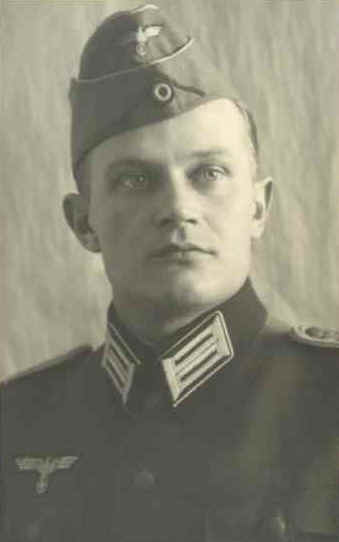
|
| Career
Field |
English
Translation |
Collar
Patch |
Description |
| Hoeherer Dienst |
Higher Services |
 
|
Officer
equivalents wore gold embroided collar patches.
General equivalents wore a patch identical to
Army Generals with two exceptions; the field was dark green, not red, and the patch was
piped, like all other Beamten patches, in Nebenrfarbe. |
| Gehobener Dienst |
Elevated Services |
 |
A
patch similar to Army officers, but with dark green waffenfarbe stripes, and nebenfarbe
piping, was worn by both these services.
While a movment was made to differentiate the
insignia of these two categories, it never came to fruition, and both services wore the
same type of collar patch, as well as retaining the right to wear the collar patches of
the einfacher Dienst on the Feldbluse. |
| Mitteler Dienst |
Middle Services |
| Einfacher Dienst |
Simple Services |
 
|
Collar patches
were of the same size and shape as those worn by Enlisted Men in the Army, though the
insignia was generally embroidered in grey artificial silk by hand or machine. The
three bars were also grey, and the patch itself was piped on three sides in Nebenfarbe.
Sometimes universal pattern Enlisted Men's collar patches with dark green stripes
were substituted, but these were piped in Nebenfarbe also. |


Other uniform details - Beamten
generally wore the Army officer's uniform with appropriate insignia. Because they
were repsonsible for purchasing their own clothing, enlisted-equivalent Beamten were also
permitted to wear the officer's quality uniform -- this would have included boots and
breeches. General officer officials wore general's breeches with the broad red
"Besatzstreifen." Officer-equivalent officials wore the breast eagle of
aluminum thread/bullion embroidery (gold for generals) while those of the einfacher Dienst
wore the enlisted eagle.
Headgear conformed to the respective officer versus enlisted
patterns with corresponding insignia except that, before its discontinuation in 1942,
enlisted-equivalent officials had been permitted to wear the cap knowns as the
"officer's old style field cap" (often called a "crusher" among
collectors) with white woven insignia in place of the silver worn by
officer-equivalent ranks (those who owned this cap could continue to wear it for the life
of the cap even after official discontinuation). Piping on the old style and peaked
caps was in dark green, as was the soutache chevron on the M-38. General officer
official's caps were piped in gold around the top of the crown and the bottom of the cap
band in gold while the upper cap band was in the secondary colour. General's M-38
caps bore gold piping with a dark green soutache.
Belts conformed to the same officer/enlisted divisions with
generals showing gold-coloured buckles.
Officials were not to wear unit insignia (number, cyphers,
etc.) on their shoulder boards, nor were they permitted to wear cuff titles other than
those that were considered campaign awards (e.g., AFRIKA or KRETA) in "elite"
units. Beamten had been permitted the Waffenrock prior to the war's outbreak --
officer-equivalent personnel could also wear the officer's (or general's) brocade belt,
dagger, and augillette although at one point there was a plan to provide at least a
specially-designed dress belt for officials; this never came to fruition.
WARTIME CHANGES - Officials for the Duration of the
War
Another category of offical was introduced after the outbreak
of war; those who lacked the qualifications to be full-fledged officials but who possessed
critically-needed skills were appointed as "Beamter auf Kriegsdauer"
(Officials for the Duration of the War). Their secondary colour (Nebenfarbe) was
light grey for all specialties (to add more confusion, the career fields were the same as
the active officials), shoulder board devices were silver coloured, and special collar
patches on a light grey background piped in dark green were worn.
| Career
Field |
English
Translation |
Collar
Patch |
Description |
| Hoeherer Dienst |
Higher Services |
 |
The special patch in gold on a
light grey background piped in dark green with gold stripe. |
| Gehobener Dienst |
Elevated Services |
 |
The special patch in
silver on a light grey background piped in dark green with dark green stripe. |
| Mitteler Dienst |
Middle Services |
| Einfacher Dienst |
Simple Services |
 |
The special patch in grey on a
light grey background piped in dark green with dark green stripe. |
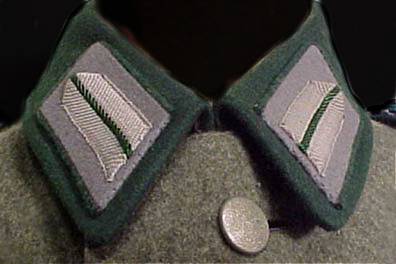
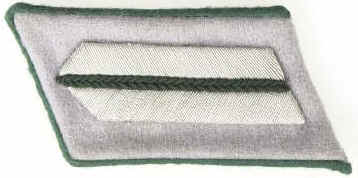
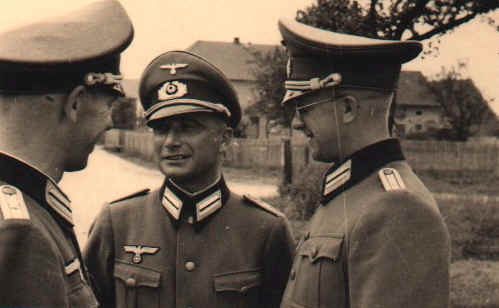
Cap bands for officer's caps (both the dress cap and the
"crusher"), as well as field blouse and greatcoat collars, and the soutache on
the new style field cap, all were to be rendered in blue-grey. This was the same
uniform colour worn by the Luftwaffe, and in fact, Luftwaffe basic cloth was supposed to
be utilized.
Example - the following examples come from
the books Uniformen der deutschen Wehrmacht published in April 1939, and The
German Army - Men at Arms 320 and give an idea of the complexity of Beamten
ranks, titles, and career fields.
The following tables are of interest; note that all grades of
apothecaries (pharmacists) were part of the hoeherer Dienst, even a Leutnant-equivalent,
while a Major-equivalent paymaster (for example) was not. The reason for this is
that all pharmacists were university graduates. In general, the Senior Career field
had university education as a prerequisite; Advanced and Intermediate were for former
Unteroffiziere mit Portepee (senior NCOs) with two years training at service colleges, and
the Junior career field was for junior NCOs or men with little training.
Armed Forces Officials (Apothecaries)
Nebenfarbe - Light Green, HV appears on the shoulder boards |
All belonged to hoeherer Dienst (Senior Career) |

Feldapotheker
|

Oberstabsapotheker |

Oberapotheker
|

Oberfeldapotheker |

Stabsapotheker
|
|
|
|





























































